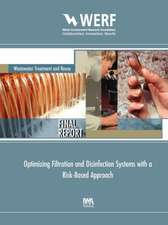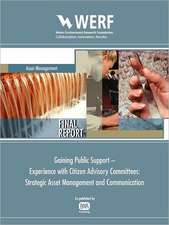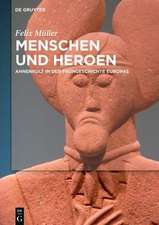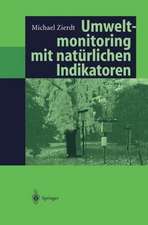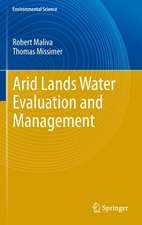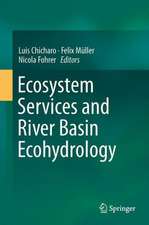Eco Targets, Goal Functions, and Orientors
Editat de Felix Müller, Maren Leupelten Limba Engleză Paperback – 13 noi 2012
| Toate formatele și edițiile | Preț | Express |
|---|---|---|
| Paperback (1) | 960.93 lei 43-57 zile | |
| Springer Berlin, Heidelberg – 13 noi 2012 | 960.93 lei 43-57 zile | |
| Hardback (1) | 967.22 lei 43-57 zile | |
| Springer Berlin, Heidelberg – 8 apr 1998 | 967.22 lei 43-57 zile |
Preț: 960.93 lei
Preț vechi: 1171.86 lei
-18% Nou
Puncte Express: 1441
Preț estimativ în valută:
183.93€ • 199.86$ • 154.60£
183.93€ • 199.86$ • 154.60£
Carte tipărită la comandă
Livrare economică 21 aprilie-05 mai
Preluare comenzi: 021 569.72.76
Specificații
ISBN-13: 9783642637209
ISBN-10: 3642637205
Pagini: 644
Ilustrații: XVIII, 621 p.
Dimensiuni: 155 x 235 x 34 mm
Greutate: 0.89 kg
Ediția:Softcover reprint of the original 1st ed. 1998
Editura: Springer Berlin, Heidelberg
Colecția Springer
Locul publicării:Berlin, Heidelberg, Germany
ISBN-10: 3642637205
Pagini: 644
Ilustrații: XVIII, 621 p.
Dimensiuni: 155 x 235 x 34 mm
Greutate: 0.89 kg
Ediția:Softcover reprint of the original 1st ed. 1998
Editura: Springer Berlin, Heidelberg
Colecția Springer
Locul publicării:Berlin, Heidelberg, Germany
Public țintă
ResearchCuprins
1 Introduction: Targets, Goals and Orientors.- 1 Targets, Goals and Orientors.- 2 The Theoretical Approach: Tendencies of Ecosystem Development.- 2.1 The Physical Basis of Ecological Goal Functions - Fundamentals, Problems and Questions.- 2.2 Ecological Orientors: Emergence of Basic Orientors in Evolutionary Self-Organization.- 2.3 Ecological Orientors: Pattern and Process of Succession in Relation to Ecological Orientors.- 2.4 Thermodynamic Orientors: Exergy as a Goal Function in Ecological Modeling and as an Ecological Indicator for the Description Ecosystem Development.- 2.5 Thermodynamic Orientors: Exergy as a Holistic Ecosystem Indica-tor: A Case Study.- 2.6 Thermodynamic Orientors: How to Use Thermodynamic Concepts in Ecology.- 2.7 Thermodynamic Orientors: A Review of Goal Functions and Ecosys-tern Indicators.- 2.8 Network Orientors: Steps Towards a Cosmography of Ecosystems: Orientors for Directional Development, Self-Organization, and Autoevolution.- 2.9 Network Orientors: A Utility Goal Function Based on Network Synergism.- 2.10 Network Orientors: Theoretical and Philosophical Considerations why Ecosystems may Exhibit a Propensity to Increase in Ascendency.- 2.11 Applying Thermodynamic Orientors: Goal Functions in the Holling Figure-Eight Model.- 2.12 Quantifying Ecosystem Maturity - a Case Study.- 2.13 Case Studies: Orientors and Ecosystem Properties in Coastal Zones.- 2.14 Case Studies: Modeling Approaches for the Practical Application of Ecological Goal Functions.- 2.15 Case Studies: Soil as the Interface of the Ecosystem Goal Function and the Earth System Goal Function.- 2.16 The Physical Basis of Ecological Goal Functions - Fundamentals, Problems and Questions.- 3 The Philosophical Basis: Aspects from Evolution Theory and Philosophy of Science.- 3.1 Introduction: Philosophical Aspects of Goal Functions.- 3.2 The Relativity of Orientors: Interdependence of Potential Goal Functions and Political and Social Developments.- 3.3 Constructions of Environmental Issues in Scientific and Public Discourse.- 3.4 Ethics and Environment: How to Found Political and SocioEconomic Targets.- 3.5 Teleology and Goal Functions: What are the Concepts of Optimality and Efficiency in Evolutionary Biology.- 3.6 Conclusions: A Generalizing Framework for Biological Orientation.- 4 The Diversity of Targets: Problems of Combining Natural and Human Orientors.- 4.1 Introduction: Human Targets in Relation to Land Use.- 4.2 Ecosystem and Society: Orientation for Sustainable Development.- 4.3 Human Orientors: A System Approach for Transdisciplinary Com-munication of Sustainable Development by Using Goal Functions.- 4.4 Human Orientors: Ecological Targets and Environmental Law.- 4.5 Applying Thermodynamic Orientors: Coupled Economic and Envi-ronmental Growth and Development.- 4.6 Ecological- Economic Budgets: Society’s Maneuver Towards Sus-tainable Development: Information and the Setting of Target Values.- 4.7 Targets of Nature Conservation: Consequences for Ecological and Economic Goal Functions.- 4.8 Conclusion: Sustainability as a Level of Integration for Diverging Targets?.- 5 The Practical Consequences: Eco Targets as Goal Functions in Environmental Management.- 5.1 Introduction: Orientors and Goal Functions for Environmental Planning - Questions and Outlines.- 5.2 Integrating Diverging Orientors: Quantifying the Interaction of Human and the Ecosphere: The Sustainable Process Index.- 5.3 Applying Thermodynamic Orientors: The Use of Exergy as an Indi-cator in Environmental Management.- 5.4 Integrating Diverging Orientors: Time Scale Effects withRespect to Sustainability.- 5.5 Deriving Eco Targets from Ecological Orientors: Goals of Nature Conservation and their Realization on the Landscape Scale.- 5.6 Applying Thermodynamic Orientors: Tools of Orientor Optimiza-tion as a Basis for Decision Making Process.- 5.7 Deriving Eco Targets from Ecological Orientors: Marine Ecological Quality Objectives: Science and Management Aspects.- 5.8 Deriving Eco Targets from Ecological Orientors: Goals and Orien-tors of an Integrated Regional Planning for a Sustainable Land-Use.- 5.9 Deriving Eco Targets from Ecological Orientors: Ecological Orien-tors for Landscape Planning.- 5.10 Integrating Diverging Orientors: Sustainable Agriculture: Ecological Targets and Future Land-Use Changes.- 5.11 Conclusion: Potentials and Limitations of a Practical Application of the Eco Target and Orientor Concept.- 6 Coclusion: Targets, Goals and Orientors.- 6 Targets, Goals and Orientors: Concluding and Re-Initializing the Discussion.
Textul de pe ultima copertă
This book introduces a new concept in ecosystem theory and discusses it in an interdisciplinary framework, originating in succession theory, network theory and thermodynamics. The central hypothesis claims that there are certain system attributes which are regularly optimized in the course of ecosystem development. Many of these orientators can also be interpretated as general attributes for self-organizing processes. As a result of the discussions, a new quality of a holistic environmental management is designed, capable of integrating the ideas of sustainability, ecological integrity, and ecosystem health.

